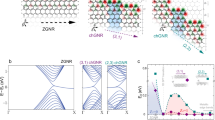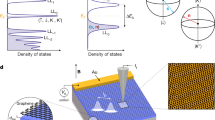Abstract
Chirality—or ‘handedness’—is a symmetry property crucial to fields as diverse as biology, chemistry and high-energy physics. In graphene, chiral symmetry emerges naturally as a consequence of the carbon honeycomb lattice. This symmetry can be broken by interactions that couple electrons with opposite momenta in graphene. Here we directly visualize the formation of Kekulé bond order, one such phase of broken chiral symmetry, in an ultraflat graphene sheet grown epitaxially on a copper substrate. We show that its origin lies in the interactions between individual vacancies in the copper substrate that are mediated electronically by the graphene. We show that this interaction causes the bonds in graphene to distort, creating a phase with broken chiral symmetry. The Kekulé ordering is robust at ambient temperature and atmospheric conditions, indicating that intercalated atoms may be harnessed to drive graphene and other two-dimensional materials towards electronically desirable and exotic collective phases.
This is a preview of subscription content, access via your institution
Access options
Subscribe to this journal
Receive 12 print issues and online access
$209.00 per year
only $17.42 per issue
Buy this article
- Purchase on Springer Link
- Instant access to full article PDF
Prices may be subject to local taxes which are calculated during checkout






Similar content being viewed by others
References
Castro Neto, A. H., Guinea, F., Peres, N. M. R., Novoselov, K. S. & Geim, A. K. The electronic properties of graphene. Rev. Mod. Phys. 81, 109–162 (2009).
Hou, C.-Y., Chamon, C. & Mudry, C. Electron fractionalization in two-dimensional graphenelike structures. Phys. Rev. Lett. 98, 186809 (2007).
Ryu, S., Mudry, C., Hou, C. Y. & Chamon, C. Masses in graphenelike two-dimensional electronic systems: topological defects in order parameters and their fractional exchange statistics. Phys. Rev. B 80, 205319 (2009).
Weeks, C. & Franz, M. Interaction-driven instabilities of a Dirac semimetal. Phys. Rev. B 81, 085105 (2010).
García-Martínez, N. A., Grushin, A. G., Neupert, T., Valenzuela, B. & Castro, E. V. Interaction-driven phases in the half-filled spinless honeycomb lattice from exact diagonalization. Phys. Rev. B 88, 245123 (2013).
Cheianov, V. V., Fal’ko, V. I., Syljuåsen, O. & Altshuler, B. L. Hidden Kekulé ordering of adatoms on graphene. Solid State Commun. 149, 1499–1501 (2009).
Cheianov, V. V., Syljuåsen, O., Altshuler, B. L. & Fal’ko, V. Ordered states of adatoms on graphene. Phys. Rev. B 80, 233409 (2009).
Kopylov, S., Cheianov, V., Altshuler, B. L. & Fal’ko, V. I. Transport anomaly at the ordering transition for adatoms on graphene. Phys. Rev. B 83, 201401 (2011).
Chamon, C. Solitons in carbon nanotubes. Phys. Rev. B 62, 2806–2812 (2000).
Su, W. P., Schrieffer, J. R. & Heeger, A. J. Solitons in polyacetylene. Phys. Rev. Lett. 42, 1698–1701 (1979).
Nambu, Y. & Jona-Lasinio, G. Dynamical model of elementary particles based on an analogy with superconductivity. I. Phys. Rev. 122, 345–358 (1961).
Gomes, K. K., Mar, W., Ko, W., Guinea, F. & Manoharan, H. C. Designer Dirac fermions and topological phases in molecular graphene. Nature 483, 306–310 (2012).
Hou, C.-Y., Chamon, C. & Mudry, C. Deconfined fractional electric charges in graphene at high magnetic fields. Phys. Rev. B 81, 075427 (2010).
Checkelsky, J. G., Li, L. & Ong, N. P. Zero-energy state in graphene in a high magnetic field. Phys. Rev. Lett. 100, 206801 (2008).
Marianetti, C. A. & Yevick, H. G. Failure mechanisms of graphene under tension. Phys. Rev. Lett. 105, 245502 (2010).
Brown, L. et al. Polycrystalline graphene with single crystalline electronic structure. Nano Lett. 14, 5706–5711 (2014).
Gao, L., Guest, J. R. & Guisinger, N. P. Epitaxial graphene on Cu(111). Nano Lett. 10, 3512–3516 (2010).
Zhao, L. et al. Influence of copper crystal surface on the CVD growth of large area monolayer graphene. Solid State Commun. 151, 509–513 (2011).
Coraux, J., N’Diaye, A. T., Busse, C. & Michely, T. Structural coherency of graphene on Ir(111). Nano Lett. 8, 565–570 (2008).
Arguello, C. J. et al. Visualizing the charge density wave transition in 2H-NbSe2 in real space. Phys. Rev. B 89, 235115 (2014).
Ruffieux, P. et al. Charge-density oscillation on graphite induced by the interference of electron waves. Phys. Rev. B 71, 153403 (2005).
Rutter, G. M. et al. Scattering and interference in epitaxial graphene. Science 317, 219–222 (2007).
Deshpande, A., Bao, W., Miao, F., Lau, C. N. & LeRoy, B. J. Spatially resolved spectroscopy of monolayer graphene on SiO2 . Phys. Rev. B 79, 205411 (2009).
Mallet, P. et al. Role of pseudospin in quasiparticle interferences in epitaxial graphene probed by high-resolution scanning tunneling microscopy. Phys. Rev. B 86, 045444 (2012).
Song, C.-L. et al. Charge-transfer-induced cesium superlattices on graphene. Phys. Rev. Lett. 108, 156803 (2012).
Schmid, M. & Varga, P. in The Chemical Physics of Solid Surfaces Vol. 10 (ed. Woodruff, D. P.) 118–151 (Elsevier, 2002).
Starodub, E. et al. Graphene growth by metal etching on Ru (0001). Phys. Rev. B 80, 235422 (2009).
Günther, C., Vrijmoeth, J., Hwang, R. Q. & Behm, R. J. Strain relaxation at hexagonally close-packed metal–metal interfaces. Phys. Rev. Lett. 74, 754–757 (1995).
Hamilton, J. C. & Foiles, S. M. Misfit dislocation structure for close-packed metal–metal interfaces. Phys. Rev. Lett. 75, 882–885 (1995).
Shao, S., Wang, J., Misra, A. & Hoagland, R. G. Spiral patterns of dislocations at nodes in (111) semi-coherent FCC interfaces. Sci. Rep. 3, 2448 (2013).
Zhao, L. et al. Visualizing individual nitrogen dopants in monolayer graphene. Science 333, 999–1003 (2011).
Brar, V. W. et al. Gate-controlled ionization and screening of cobalt adatoms on a graphene surface. Nature Phys. 7, 43–47 (2011).
Otero, G. et al. Ordered vacancy network induced by the growth of epitaxial graphene on Pt(111). Phys. Rev. Lett. 105, 216102 (2010).
Meunier, I., Tréglia, G., Gay, J.-M., Aufray, B. & Legrand, B. Ag/Cu(111) structure revisited through an extended mechanism for stress relaxation. Phys. Rev. B 59, 10910–10917 (1999).
van Gastel, R., Somfai, E., van Albada, S. B., van Saarloos, W. & Frenken, J. W. Nothing moves a surface: vacancy mediated surface diffusion. Phys. Rev. Lett. 86, 1562–1565 (2001).
Dean, C. R. et al. Boron nitride substrates for high-quality graphene electronics. Nature Nanotech. 5, 722–726 (2010).
Stöhr, J. NEXAFS Spectroscopy Vol. 25 (Springer Science & Business Media, 2013).
Brühwiler, P. A. et al. π∗ and σ∗ excitons in C 1s absorption of graphite. Phys. Rev. Lett. 74, 614–617 (1995).
Giannozzi, P. et al. QUANTUM ESPRESSO: a modular and open-source software project for quantum simulations of materials. J. Phys. Condens. Matter 21, 395502 (2009).
Tersoff, J. & Hamann, D. Theory and application for the scanning tunneling microscope. Phys. Rev. Lett. 50, 1998–2001 (1983).
Plimpton, S. Fast parallel algorithms for short-range molecular dynamics. J. Comput. Phys. 117, 1–19 (1995).
Stukowski, A. Visualization and analysis of atomistic simulation data with OVITO–the open visualization tool. Model. Simul. Mater. Sci. Eng. 18, 015012 (2010).
Acknowledgements
We thank G. W. Flynn, C. Marianetti, I. L. Aleiner, B. L. Altshuler and C. J. Arguello for helpful discussions and L. Zhao for sharing Gr-Cu(111) bulk crystal data. This work is supported by the Office of Naval Research (ONR) (award number N00014-14-1-0501, C.G.) and by the Air Force Office of Scientific Research (AFOSR) (award number FA9550-11-1-0010, A.N.P.). Work at Cornell University is supported by the NSF through the Cornell Center for Materials Research (NSF DMR-1120296) (J.P.). Support for synthesis and characterization was provided by ONR (N00014-12-1-0791) (K.M.S.), AFOSR (FA9550-11-1-0033 and FA2386-13-1-4118) (J.P.) and the Nano Material Technology Development Program through the National Research Foundation of Korea (NRF) funded by the Ministry of Science, ICT, and Future Planning (2012M3A7B4049887) (J.P.). NEXAFS data was measured at beamline 8-2 at the Stanford Synchrotron Radiation Lightsource, a National User Facility operated by Stanford University on behalf of the US Department of Energy, Office of Basic Energy Sciences (T.S., D.N.) and supported (T.S.) by the NSF MRSEC Program through Columbia in the Center for Precision Assembly of Superstratic and Superatomic Solids (DMR-1420634).
Author information
Authors and Affiliations
Contributions
C.G. measured and analysed STM and Raman spectroscopy data and performed DFT and molecular statics calculations. C.-J.K., L.B., and E.B.L. performed CVD growth of graphene samples. J.P. and K.M.S. supervised the CVD sample growth. A.N.P. supervised STM measurements. T.S. and D.N. measured and analysed NEXAFS data. All authors participated in writing the manuscript.
Corresponding author
Ethics declarations
Competing interests
The authors declare no competing financial interests.
Supplementary information
Supplementary information
Supplementary information (PDF 7492 kb)
Rights and permissions
About this article
Cite this article
Gutiérrez, C., Kim, CJ., Brown, L. et al. Imaging chiral symmetry breaking from Kekulé bond order in graphene. Nature Phys 12, 950–958 (2016). https://doi.org/10.1038/nphys3776
Received:
Accepted:
Published:
Issue Date:
DOI: https://doi.org/10.1038/nphys3776
This article is cited by
-
Realization of large-area ultraflat chiral blue phosphorene
Nature Communications (2024)
-
Pseudospin-triplet pairing in iron-chalcogenide superconductors
Communications Physics (2024)
-
Observation of Kekulé vortices around hydrogen adatoms in graphene
Nature Communications (2024)
-
Visualizing symmetry-breaking electronic orders in epitaxial Kagome magnet FeSn films
Nature Communications (2023)
-
Imaging inter-valley coherent order in magic-angle twisted trilayer graphene
Nature (2023)



